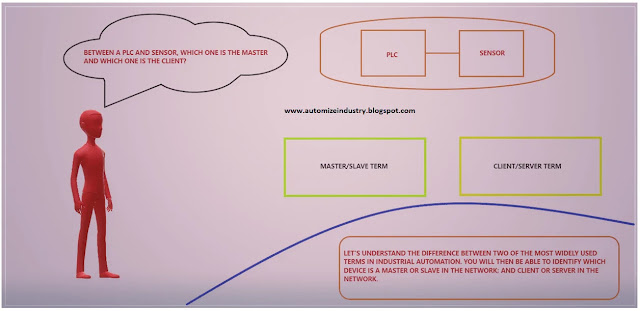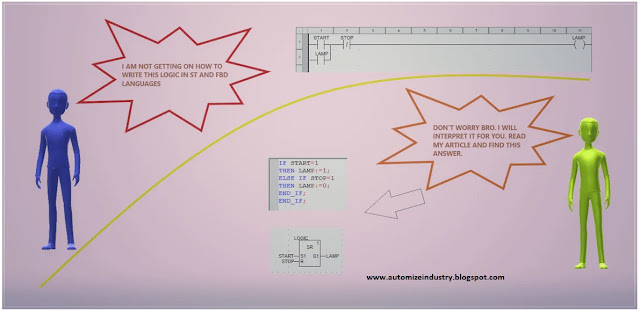Difference Between Master-Slave and Client-Server Configuration
2 Oct 2020.
In this
post, we will clarify the difference between master-slave protocol and
client-server protocol. (Click on the images for
a more zoomed view)
Hello programmers. In industrial communication, we must be well-versed
with all the basic terms which are used so that it will become easier for you
to identify the correct configuration. Many a times, we come across two words
which have the same meaning; but are slightly different in functionalities.
Today, we will come across two such protocols which are widely used in
communication and often confuses a designer in distinguishing. The first one is
the master-slave and the second one is the client-server. Referring the above
image, we will see whether the PLC is a master or slave in master-slave
configuration; and whether it is a client or server in client-server
configuration.
Two devices can communicate if they can exchange information and understand each other. First, master/slave communication originated in industrial automation whereas client/server communication originated in IT industry. Both these terms go together in communication; we just must identify the proper type of device. There are many protocols used; but people often end up getting confused in both these terms. That’s because; they think both are same protocols with same meaning.
Master-Slave vs. Client-Server:
What Is Master-Slave Architecture?
Master-slave system is the one where the master communicates with one or more slave devices. This is the general answer when a question arises as to what master and slave concept is. Basically, you can think of it is as the dominating type one. The master is the one which will initiate communication and control the slave devices timely. The slaves must respond to the master for data transfer. Each slave has it’s own identification and the master will identify it through that. The master will continuously poll for data in the network. This is the difference between a master and slave.
Client-Server Communication Protocol:
Now, the client-server protocol is the same as master-slave. Many ask
what is the difference between client and server? Here, the client is the one
which requests for data and the server will have to respond to the client for
data transfer. So, you can think of it as the democratic one. The server will
patiently wait for the client to request data. Once it gets the request, it
will respond accordingly. Once the request is over, communication won’t happen,
and the server will just wait for a request from client. This is the difference
between client and server.
Basically, a master oversees the network and the one which starts
communication. No one can talk without master’s permission. But there is no
such control protocol in client-server. It’s just a simple game of request and
response. Look at the above-mentioned data; you must have found in both the terms;
data transfer is happening but the major difference being of control. A client
can only access the data and not modify the data of server, whereas the master
has a major role in influencing the data from slaves. Both the terms just go
similar in terms of data request and response.
Now, catching up the matching terms, you can say that a master is equal
to client, whereas a slave is equal to server. The master requests for data and
the slave responds to it with the data.
So, in our topic, PLC is the master and sensor is the slave, if you look
from master-slave point. A PLC is the one which controls the network and slave
devices for data transfer. The sensor will get polling request from the PLC in
a periodic time interval and the sensor will send the data accordingly. If you
look in client-server scope, the PLC is a client, and the sensor is a server.
The PLC will request for data and the sensor will respond by sending data to
it.
In general, if you have some devices and when you want to distinguish;
it’s important to first understand the concept of that individual device. Once
you catch up the terms, it will be easier for you to design the network.
I have covered the general theory
related to these protocols. I have also not attempted to cover every type
of features deeply; you can learn it easily in the software help file or
internet. I have just given you an insight of this type of protocols. Learn the
basics and explore a new type of study in this type of automation.
Thank you, guys; I hope you enjoyed reading the practices normally used for this type of study in industrial automation.




Wow, amazing block structure! How long
ReplyDeleteHave you written a blog before? Working on a blog seems easy.
The overview of your website is pretty good, not to mention what it does.
In the content!
vstkey.com
PhpStorm Crack
Redshift Render Crack
Corel Draw X3 Keygen Crack
Drip Fx VST Crack
Macrorit Data Wiper Crack
Advance IP Scanner Crack
I like your all post. You have done really good work. Thank you for the information you provide, it helped me a lot. I hope to have many more entries or so from you.
ReplyDeleteVery interesting blog.
softwaretube.net/
Tenorshare iCareFone crack/